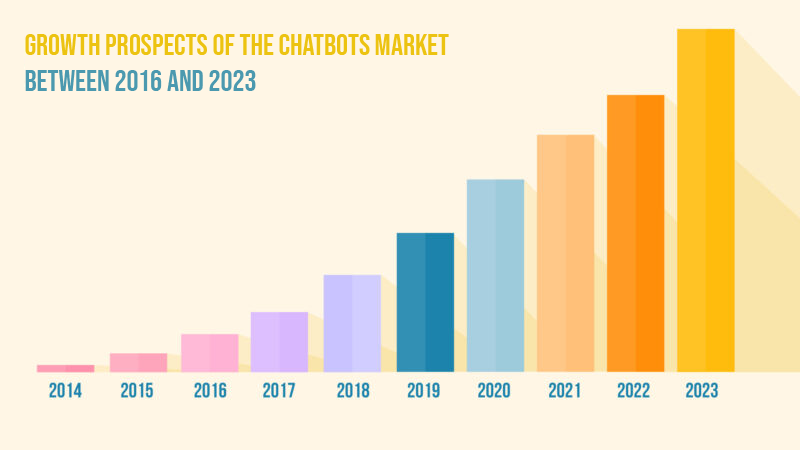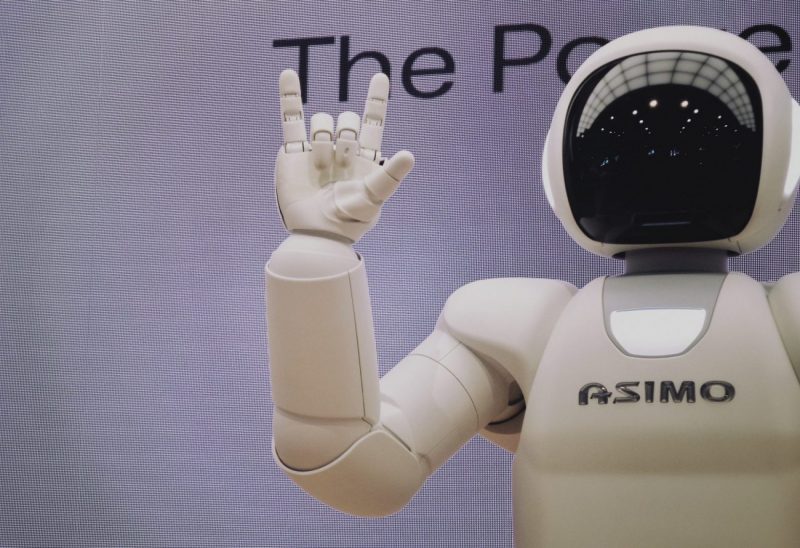Do you know the chatbots that have revolutionized virtual customer service in thousands of companies? Today we tell you all about them in detail.
INDEX
- Types of chatbots.
- Advantages of chatbots.
- Weak points.
- Strategies.
- How do they work?
- Tasks
- Why implement them in your company?
- How to create them?
- Best chatbots tools.
- Importance of chatbots.
- Trends
We’ve all interacted with a chatbot at one time, whether it’s for online shopping or making inquiries, but what are these services really?
This tool is the closest artificial intelligence system to our day-to-day lives; its main function is to help the user by resolving their doubts.
This element has been around for over 50 years, but it is now when companies are implementing this tool for their customer support functions.
Bots are part of intelligence software that aims to perform various predetermined tasks on their own.
They have the ability to process natural language (NLP), which means they can have a conversation with them.
Thanks to their learning response patterns and repeated actions, they can maintain a fluid conversation, and they also have the ability to learn from the user’s preferences.
Thanks to their responsiveness, they are ideal for eCommerce, digital banking, or any business that needs customer support.
This is the next step your company needs for the automation of actions, increasingly necessary in the digital age.
1. Types of Chatbots
Every company has a different function and requires a specific chatbot, so it is advisable to consider the diversity of chatbots and choose the one that best suits your business.
Here is a list of types of chatbots for you to select the one that best fits your company:
- ITR Chatbot (Text Interaction Response)
This type of chatbot operates through commands rather than artificial intelligence. Its interface is straightforward as it simulates a normal conversation through options on the screen.
The interaction is directed by the chatbot, allowing it to determine what the user wants to inquire about.
- Word-spotting Chatbots
This artificial intelligence system works by interpreting keywords, resulting in predetermined responses. It is unable to interpret the user’s intention or context.
Their effectiveness for the company depends on the assigned task. Additionally, there are multimedia chatbots designed to enhance the chat’s visual appeal.
- Smart Chatbots
This type of chatbot goes a step further, capable of understanding the user’s natural language. It interprets context and can generate questions from scratch, making the conversation much more fluid and dynamic.
Not only can they provide quick and argument-based responses, but they also learn gradually from interactions. Thanks to this learning, users can accomplish tasks such as booking a flight or making a bank transfer.
Depending on your company’s service, you should choose an operating system for the chatbot to determine its role. Therefore, we present some chatbots that can be useful for various departments in your company.
- Marketing Chatbot
Initiates contact with users when they visit the page, helping to collect personalized data.
- Customer Support Chatbot
One of the most commonly used services, it handles responses to consumer requests and inquiries.
- Sales Chatbot
Assists in completing the purchase in its final steps and enhances engagement on various social media platforms.
- Social Chatbot
Primarily provides personalized content on social media to consumers, increasing engagement.
2. Advantages of Chatbots
If you are hesitant about implementing chatbots in your company, here is a list of benefits for both your company and your consumers.
For the Company:
– Technological investment.
– Improvement of brand and reputation.
– Enhanced conversion rates.
– Work efficiency.
– Cost reduction.
– Improved sales strategy.
For Customers:
– Quick customer service.
– Real-time information.
– Comfortable and flexible interaction.
– Enhanced customer web experience.
– Accessibility.
– User qualification thanks.
3. Weak Points
Some users have had negative experiences dealing with chatbots, leading to reservations about engaging with them. Here are the main points to avoid to prevent customer frustration:
- No solution: One of the main reasons consumers avoid these services is when chatbots fail to help solve the problem, offering no contact with a human agent or providing no options to address the issue.
- Chatbot insistence: This occurs when the bot appears with every click the consumer makes on the website. The customer may become annoyed by repeatedly rejecting the chatbot’s assistance.
- Chatbot error: This issue arises when the bot malfunctions, preventing the user from speaking with a live agent and receiving no help from the chatbot.
- Limited options: Involves the lack of variety in options, leaving the customer unsure of which option to select as none seem to address their specific issue.
- Low comprehension: Despite advanced technology, chatbots may sometimes struggle to understand the conversation’s purpose. This can lead to repeated queries by the consumer and may result in a negative brand experience.
To address these issues, companies should develop more sophisticated chatbots that can avoid these errors and provide excellent customer service.
4. Strategies
Implementing a chatbot not only stands out as a technological innovation for the company but also involves a planned strategy to reap benefits.
Some advantages that may result from a well-implemented chatbot strategy include economic benefits generated through subscriptions, advertising, or eCommerce.
As mentioned earlier, utility exists for both the company and the consumer.
Time savings, diverse subscription models, or the replacement of search engines can be proactive elements for the business in question.
5. How Do They Work?
The primary goal of a chatbot is to help consumers solve their problems, made possible through artificial intelligence and machine learning.
Many chatbots can even learn user preferences and interpret information.
With the improvement of chatbots, customer service has experienced notable progress, enabling companies to offer quick and flexible solutions without the need to wait for a human agent.
6. Tasks
Chatbots are responsible for only two tasks, but they can significantly lighten the workload of a company to a higher level.
– Analyzing the problem:
Once in contact with a chatbot, it analyzes the problem to categorize it into different types and offer various possible solutions to the consumer.
– Responding to questions:
After the problem has been analyzed, the chatbot takes care of responding with different solutions. This response action can take various forms:
- Predetermined responses.
- Asking a question to clarify the reason for the inquiry.
- Providing company information.
- Offering personalized information based on the provided data.
7. Why Implement it in Your Company?
Technology has brought numerous advantages to businesses, and one of them is chatbots, which not only help meet consumer needs but also provide a way to connect with customers.
During the purchasing process, users often experience a distant feeling from the company since they are not interacting with a person. Implementing chatbots can bridge this gap and make users feel that the company is offering guidance in various areas.
In essence, through eCommerce, this system humanizes the purchase. While this may seem highly advanced and dependent on Artificial Intelligence, the implementation of this service is cost-effective and adaptable to any business, regardless of its sector.
Thanks to chatbots, consumers can stay connected with the company 24/7, allowing them to seek assistance without waiting, even in the early hours. This increases consumer engagement and reduces costs during those time periods.
User experience is significantly enhanced as the chatbot can provide flexible and convenient assistance. This also enables quicker navigation, as the chatbot is available to help with any queries.
8. How to Create Them?
There are numerous tools that assist in the creation, training, and adaptation of chatbots to websites. However, the first thing to clarify is the goal this service should fulfill.
For example, a small auto repair shop providing hours, location, repair inquiries, or appointment scheduling will have different needs compared to other sectors.
Let’s use this example to outline the steps to follow when creating your own chatbot.
– Training:
Once the goals are clear, the chatbot needs to be trained to respond to any question.
For instance, when dealing with inquiries about operating hours, formulate various ways of asking this question so that the chatbot can detect it in any form.
This way, it will be trained to respond automatically, providing the consumer with the needed answer. Specific and direct responses should be programmed to leave no room for ambiguity.
– Dialogue flow:
As mentioned, once a user asks a question, the chatbot must provide a specific and direct response. However, this is only possible for straightforward questions like hours or address.
For questions with multiple options, such as scheduling an appointment or inquiring about a specific vehicle, the chatbot will function differently.
How do we train our chatbot in this case? It’s straightforward. Each question is considered a node, so if a question has various options, the chatbot should offer a variety of subnodes.
This way, the chatbot will maintain a consistent dialogue flow until it provides the option the consumer wants. Another aspect to consider is the confidence threshold. This component helps configure the bot’s reliability in responding to a question. In other words, setting a high confidence threshold means the bot will only link this intention to the corresponding node when it’s very certain.
Conversely, setting a low confidence threshold may result in the bot confusing consumer intentions and causing confusion.
This is one of the elements that must be configured precisely so that the user doesn’t feel misunderstood by the bot and cut off the connection.
9. Best Chatbot Tools
Now that you know how to create your own chatbot, you may wonder which system to use. Here’s a small list that can help you select the program to assist you in creating one.
– Chatfuel:
This program is mainly focused on Facebook and helps create chatbots without any coding. It offers variety in terms of chatbot design, and you can configure the options the chatbot provides. This bot operates with predetermined phrases using intention recognition.
– Aivo:
This bot adapts to all business sectors and allows the company to respond to customers in real-time, whether through text or voice. This allows for bot personalization.
– itsAlive:
This bot works through keyword recognition and offers various ways for companies to communicate through an external platform. Consumers won’t feel the frustration of searching for how to contact customer service; instead, there will be a specific platform.
– Imperson:
This is one of the star bots, with clients such as Disney, Hyundai, or Johnson and Johnson. If you’re looking for experience in creating a bot, this platform is suitable for you.
10. Importance of Chatbots
The need for chatbots today is imminent, prompting giants in the industry like Samsung or Microsoft to invest in this field.
Artificial intelligence will be the element that changes how we work, making everything simpler. Automation, natural language understanding, and machine learning are just a few elements that are growing each day.
In the future, these technologies will help businesses have simpler operations and provide consumers with more pleasant user experiences.
Specifically, chatbots are one of the most widely used services, with companies giving them high ratings. According to a Statista survey, more than half of B2B companies view chatbots as an effective marketing strategy, perceiving them as successful.
In recent years, this sector has experienced continuous growth, with forecasts predicting further increases in the future. It is estimated that by 2030, chatbots in the banking and financial services sector will be valued at $6.83 billion. For the coming year, businesses are expected to save $8 billion in operating costs, according to Juniper Research. Thanks to chatbots, businesses can save $0.70 per interaction with a customer.
However, not only will there be economic benefits, but you’ll also have a winning strategy, as the growth of this sector in 2022 is estimated to be $3.9 million.

Artificial intelligence will transform departments so workers have more time for important things.
In this way, bots will be responsible for trivial issues such as claims management or insurance contracting.
Thanks to this, the user experience will be redefined by 2023 due to the combination of this type of technology and the natural language of bots.
But this increase in the artificial intelligence sector is not linked to the shortage of workers. On the contrary, working together with human staff and bots could be the perfect combination to improve the business results of any company.
Due to the era of immediacy in which we live consumers demand 24-hour assistance, therefore such services can be really useful in these situations.
Most sectors, from banking to healthcare need this service to offer the customer a good deal.
11. Trends
With the rise of chatbots and high investment this sector experiences trends that could be key to business development.
- Voice recognition.
- Machine learning.
- Research bots.
- Processing of natural language.
- Relief from administrative tasks.
- Intelligent detection of users.
As we have mentioned artificial intelligence has many applications but it is expected that in the future bots can perform actions such as the following:
- Extract information.
- Translator.
- Automatic integration.
- Classify the types of texts.
- Analyze feelings.
- Recognize spam.
- Identify the language.
Use in different regions
The region estimated to grow the most will be North America in the size of its market. In contrast, APAC will experience an increase in growth rate due to the number of investments in both the public and private sector in AI technologies.
Since 2019 with 4.2 million dollars is expected to grow up to 15.7 million dollars in 2024 in this sector. Europe will also be one of the fastest growing continents in the artificial intelligence market after North America.
The ranking of territorial areas with more growth potential in the conversational intelligence sector is as follows:
- North America.
- Europe.
- APAC.
- MEA.
- Latin America.
The constant use of mobile phones, the growth of applications based on natural language and the increase of technological investments lead to an exponential increase of this sector.
This means both administrative and economic aid for businesses.
Bots require a lot of work to offer the consumer the desired function, but, if the company finally implements it through a good training.
Bots require a lot of work to give the consumer the desired function, but if the company finally implements it through good training, the benefits of these are enormous.
So you’ll be winning this tech battle.
The future is full of technological services that will help us both personally and business, in fact, the journey of chatbots has only just begun.
Thanks to the investment in artificial intelligence of large companies, these systems will go far in the coming years changing both the way companies interact and that of consumers.





